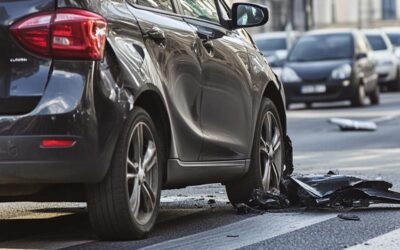According to the Colorado Department of Transportation, In 2021, there was a reported 29,927 front to rear car accidents in the state of Colorado. In addition, front-to-rear accidents account for nearly ⅓ of total accidents in Colorado and have been the leading type of accident over the past 11 years.
This blog post will discuss how to proceed if you have been in or caused a rear-end accident.
What defines and causes rear-end car accidents?
Rear-end accidents are more common than you may have thought. A rear-end accident is classified as “a vehicles that collides into the backside of the one in front of it.”
Rear-end accidents can happen for several reasons, including:
- Distracted driving: In 2020, distracted drivers were involved in 10,166 crashes on Colorado roads, resulting in 1,476 injuries and 68 fatalities. Distract driving includes but is not limited to changing the radio, eating, and talking to a passenger.
- Using a cellphone: Using your cellphone while driving is strictly prohibited while driving in Colorado unless you’re making a voice call with headphones. Regardless 41% had sent a message, whereas 54% had read a message while actively behind the wheel.
- Braking: Braking can look like the leading driver braking suddenly to avoid an obstacle in their path. This would be considered a valid reason. Or braking could look like the leading driver braking suddenly for an invalid reason, also called “brake-checking” the rear driver.
- Maintenance: It’s essential to maintain your car correctly and ensure that all safety elements are always working. Not completing the proper care results in broken turn signals or brake lights that the rear vehicle would depend on to see if you are turning or braking.
These are just a few top reasons leading to a front-to-rear accident.
Who is at Fault in Colorado in a rear-end accident?
Colorado is considered an “at-fault state,” meaning you must file claims with the other driver’s insurance company when there is property damage in your car or if you get hurt in a car accident. In most instances, the rear-end driver is the cause of a front-to-rear collision. However, this is not always the case. There are some instances when the leading driver will be the at-fault party.
Common instances when the rear driver may be at fault:
- If they cause an accident while they are on their phone and not paying attention to the traffic in front of them.
- If they cause an accident when they drop something on the floorboard and reach down to pick it up.
- If they cause an accident while trying to calm a child in the back seat of their vehicle.
Common instances when the driver in front may be at fault:
- If they cause an accident because they have not performed the proper maintenance on their car, such as fixing a tail light, the rear vehicle cannot see when they brake or turn.
- If they cause an accident because they fail to signal when turning.
- If they cause an accident while brake-checking the rear driver in a fit of road rage.
Injuries You May Sustain During a Rear-End Accident
If you were in a rear-end accident, here is a list of some of the top injuries caused by this type of accident.
- Whiplash
- Neck, back, and spinal injuries
- Internal injuries
- Concussions
- Hand, wrist, and arm injuries
- Fatalities
What to do if you were involved in a rear-end accident?
If you or a loved one have been involved in a rear-end accident, you know it can be a traumatizing event. What do you do first? Call the police or call your insurance? Should you call a lawyer or go to a doctor? Will you need photos for evidence? Being prepared for anything when you hit the road is always nice. Click here for a checklist that you can print off and keep on hand in the unfortunate event you’re involved in a car accident.
If you have been injured in a rear-end car accident in Colorado, you may be entitled to compensation for medical bills, lost earnings, property damage, and pain and suffering. Contact the experts at Cave Law today for a free consultation.





